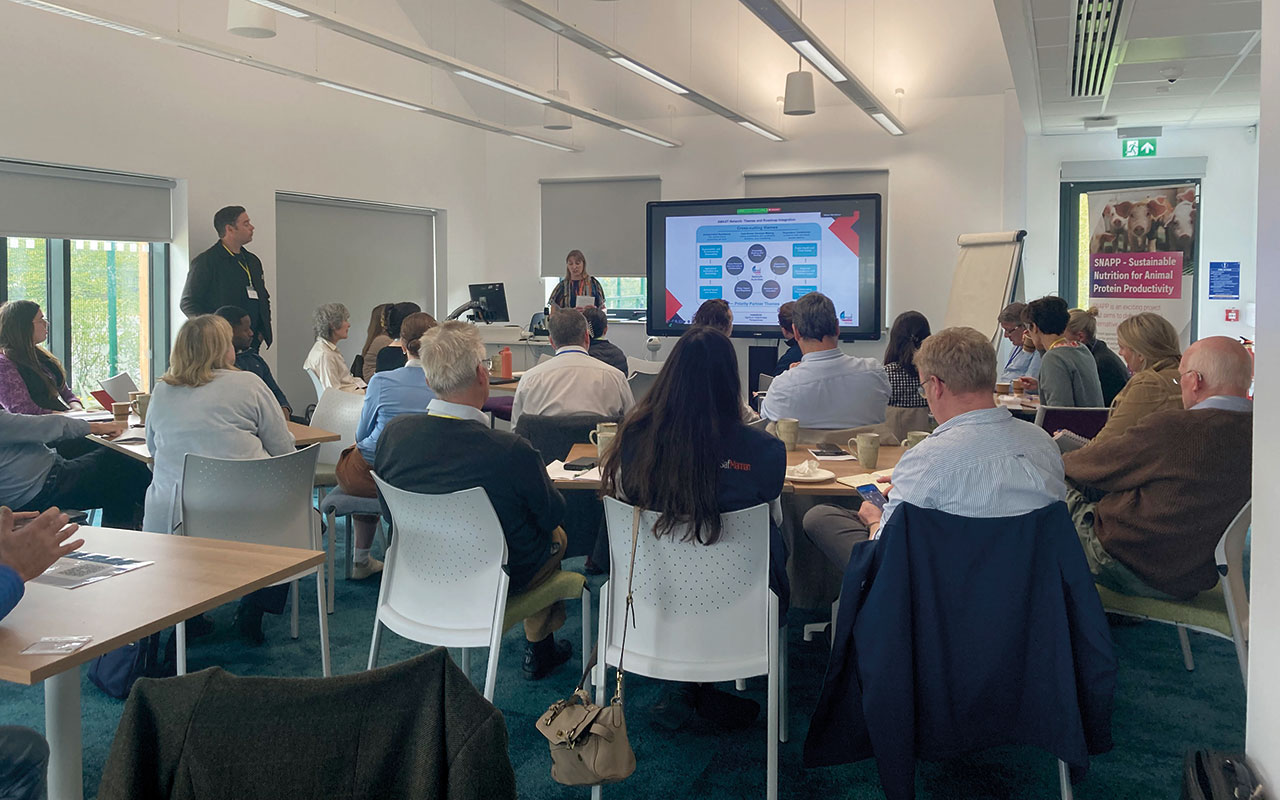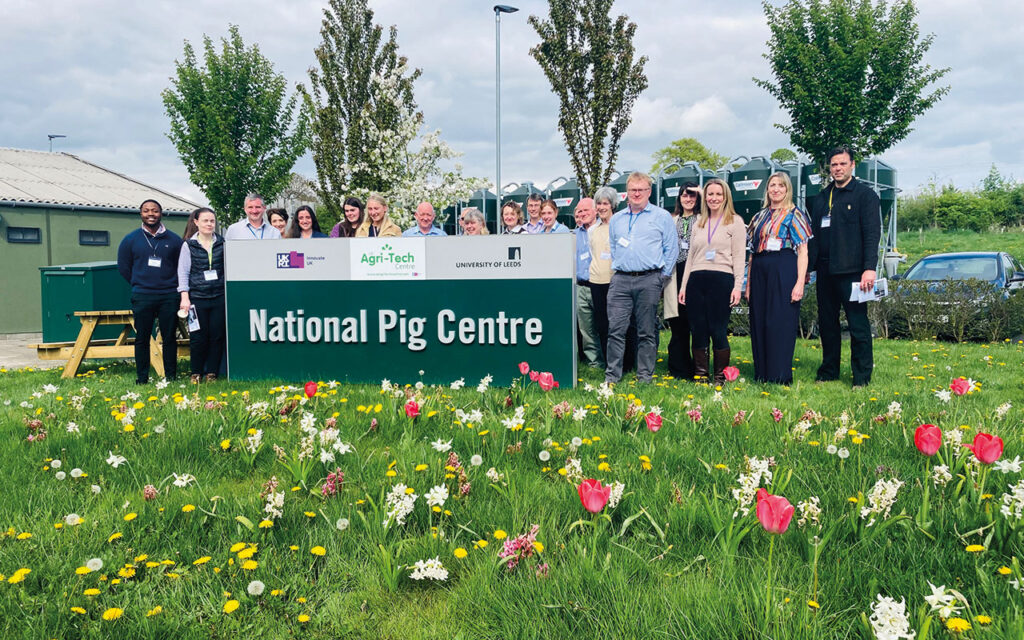Producers, vets, researchers and key stakeholder organisations came together recently to explore whether the pig sector can further refine and reduce antibiotic use in ways that don’t compromise the health and welfare of pigs, nor the mental health of producers.
The event at Leeds University’s National Pig Centre identified key challenges and opportunities to help achieve this, including biosecurity, staffing and training and help with disease diagnosis and surveillance.
“It was really valuable simply having the space and time for everyone to be in the same room, including organisations such as the Veterinary Medicines Directorate, to understand the producer’s perspective,” said Dan Tucker, from Cambridge Veterinary School and president of the Pig Veterinary Society.
He spearheaded the event in collaboration with AMAST – a transdisciplinary community covering the full agri-food supply chain.
Producer Helen Mutimer, who runs a herd of 700 outdoor sows with husband Rob in Norfolk, explained that huge strides had been made in their business in the past 15 years, moving away from in-feed to in-water medication, for example, and now their antibiotic use ranges from 5-25mg/kg.
“We can reduce antibiotics further, but we need help from others in the industry to do it,” Mrs Mutimer said. “There have been some easy wins, like using more vaccines, but now it will be more about management.”
Current picture
The global challenge of antimicrobial resistance (AMR) in humans and animals is evolving all the time. AHDB’s Mandy Nevel highlighted the government’s National Action Plan, which includes a target 30% reduction in antimicrobial use in pigs between 2024 and 2029 – a very challenging target in the current context.
NPA’s Katie Jarvis said: “We’ve already done a lot to reduce antibiotic use, but we’ve reached a bit of a plateau, and we now need to work out how to maintain responsible use.”
That means refining and reducing it further and the high variability in usage between farms suggests targeted interventions and support for higher users might be a suitable approach, she added.
Positively, as well as the 75% reduction in antibiotic use between 2015 and 2022, use of critically important antibiotics (CIAs) has plummeted.
Out of the total of 2,404 holdings submitting data to eMB, 1,427 are already using less than 50mg/kg of antibiotics, which was a loose target set by the government after the 2016 O’Neill Review of AMR. The national average antibiotic usage for 2023 was 85mg/PCU, although this was up from the lowest annual usage figure 72mg/PCU in 2022.
Gut-related, respiratory and systemic disease challenges could all be underpinning antibiotic use. APHA’s GB scanning surveillance network data shows the proportion of post-weaned pigs submitted with signs of diarrhoea and gut-related disease has gradually increased between 2015 and 2024.
Recent slight increases in UK antibiotic usage may be due, in part, to the removal of zinc oxide from piglet diets to control post-weaning diarrhoea. Vaccine shortages have also been cited as a reason.
Meanwhile, pleurisy has a significant impact on farm and has remained at a similar level across the national herd for many years.
Prof Tucker highlighted Streptococcus suis as another common reason for antibiotic use, which can cause septicaemia when the infection becomes systemic, often resulting in meningitis.

Challenges and opportunities
1. Biosecurity and C&D
Consistent biosecurity is the foundation for good herd health and performance, which means less need for antibiotic treatment.
“Biosecurity is the stand-out priority,” said Ms Jarvis. “It is often such simple things that can make a big difference. The costs of investment in biosecurity and training do get paid for in improved health and production efficiency.”
Mrs Mutimer highlighted external measures, such as provision of wheel washes at farm or field entrances. “This acts as a ‘stop and think’ process so people ask themselves ‘what am I taking on and off the farm?’ But it’s not easy to make sure we’re getting compliance from all drivers,” she said.
Cleaning and disinfection (C&D) of buildings is another area where the industry as a whole could do better. “We need more support and advice from disinfectant product companies to help make sure we’re using disinfectant correctly,” she continued, adding that producers need to communicate clearly the detail required for biosecurity routines, and the reasons why.
2. Workforce and training
A shortage of staff and challenges with training are issues across the industry which, in turn, affect the ability to build skills and ensure compliance with biosecurity practices. The Mutimers are fortunate to have a brilliant team, but workloads can be heavy.
“Productivity has increased a lot over the past 15 years, stockwork is more complex now and, even when someone is a great stockperson, they may not necessarily be good at or interested in data recording,” said Mrs Mutimer. “We are more aware of mental health and that we have to try to look after people.”
It is a challenge for producers who are not qualified in human resources or training delivery, but still need to wear those hats. Training is available via AHDB and vet practices, but there are few other options offering pig-specific training.
3. Diagnostics and surveillance
It is also agreed that more help is needed for producers to recognise suitable pigs to submit for veterinary investigation, disease diagnosis and surveillance.
Accuracy and speed of key disease diagnosis – including swine dysentery, post-weaning diarrhoea, streptococcal infections and porcine respiratory disease complex – is a particular priority to improve, along with more targeted treatment strategies.
Mrs Mutimer explained that they regularly send samples for diagnosis of health issues, but sometimes treat the animals before they receive the results in order to get ahead of the issue; vets sometimes have to make decisions based on previous experience and empirical knowledge.
4. Investing in infrastructure
In older buildings, thorough cleaning is harder to achieve than in newer buildings, and health and performance across the industry would benefit from more modern infrastructure, including ventilation and water systems.
However, the cost of either new buildings or upgrades is a barrier, not to mention the planning process.
“Ventilation expertise is something all producers struggle with,” Mrs Mutimer added. “That’s something we need extra advice on. It would also be beneficial if government could help improve the type of grants available.”
There are often practical limitations to the options for administration of medicines – for example, if producers are unable to invest in water systems to ensure they are fit for effective in-water medication.
5. Vaccines and antimicrobial alternatives
Disease challenges in the Mutimers’ herd in recent years have included swine dysentery, Actinobacillus pleuropneumoniae (APP), salmonellosis, Glassers, bowel oedema and Streptococcus suis 2.
As a result, they have added five vaccines to the breeding herd’s programme, which has made a very positive difference to health, but more vaccinations add to the workload.
Vaccination has increased across the industry, but there is a limit to how many vaccines can be administered in a given time period. “There’s a lot of support from the health companies, but we’re hitting saturation point. If we could combine more vaccines that would be great,” said Mrs Mutimer.
There are sometimes challenges with vaccine supply and availability. Investment in research for a new generation of vaccines, as well as maintaining availability of existing vaccines, are necessary along with research into other alternatives to antibiotics and a greater focus on good gut health.
6. Lifetime gut health
Long-term gut health is essential to ensure a robust pig, better able to withstand pathogenic pressures.
Post-weaning diarrhoea has the potential to influence problems at a later stage of production, so the earlier it can be addressed the better. Nutrition plays a big part, alongside minimising pathogenic disease pressure.
7. Costs and economics
Producers and vets know they have many opportunities to further improve pig health, but many of these carry a cost.
“There are different things to consider within the Animal Health and Welfare Pathway, as well as the current focus on PRRS, to provide greater support via grants for relatively low-hanging fruit such as training, pig welfare and farm infrastructure investments,” said Prof Tucker.
“More broadly, there is more work to be done to maintain and improve market share for pork, including consumer-focused PR to communicate that some antibiotic use is important for pig welfare and zero antibiotics is not a good target – either for animals or humans.”




